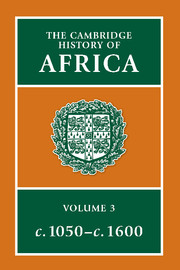Book contents
- Frontmatter
- Introduction: some interregional themes
- 1 Egypt, Nubia and the Eastern Deserts
- 2 Ethiopia, the Red Sea and the Horn
- 3 The East Coast, Madagascar and the Indian Ocean
- 4 The eastern Maghrib and the central Sudan
- 5 The western Maghrib and Sudan
- 6 Upper and Lower Guinea
- 7 Central Africa from Cameroun to the Zambezi
- 8 Southern Africa
- 9 The East African interior
- Bibliographical Essays
- Bibliography
- Index
- References
8 - Southern Africa
Published online by Cambridge University Press: 28 March 2008
- Frontmatter
- Introduction: some interregional themes
- 1 Egypt, Nubia and the Eastern Deserts
- 2 Ethiopia, the Red Sea and the Horn
- 3 The East Coast, Madagascar and the Indian Ocean
- 4 The eastern Maghrib and the central Sudan
- 5 The western Maghrib and Sudan
- 6 Upper and Lower Guinea
- 7 Central Africa from Cameroun to the Zambezi
- 8 Southern Africa
- 9 The East African interior
- Bibliographical Essays
- Bibliography
- Index
- References
Summary
Southern Africa can be divided into two ecological regions with sharply contrasting historical evolutions. The huge western zone consisting of South-West Africa, Botswana and the western Cape remained until 1600 a predominantly non-agricultural area. The peoples who occupied sparsely the vast expanses of acacia scrubland at the centre of the Kalahari were necessarily hunter-gatherers. At its fringes, however, pastoralism was possible, and in the far north, the pastoralists had become iron-using and Bantu-speaking by the end of the period. It seems likely that Iron Age pastoralists such as the Herero had spread in a westerly direction towards the plateau of southern Angola. Elsewhere pastoralists remained Late Stone Age peoples, who were very different in language, culture and appearance from their Bantu-speaking neighbours. They lived in association with closely related hunter-gatherers, and their contacts ranged from open conflict over waterholes, grazing lands and game, to various forms of clientship and trade.
The eastern half of southern Africa, comprising Rhodesia, southern Mozambique and eastern South Africa, has a rather more complex history than the south-west. With richer soils and vegetation, heavier rainfall and more abundant mineral resources, it has been able to support a far larger population. In modern times, this population has been classified into two broad cultures. In the north-east, between the Zambezi and Limpopo, are the Shona. In the south-east, south of the Limpopo, are the South-Eastern Bantu, comprising the Sotho-Tswana of the plateau, the Nguni of the coastlands, and the Tonga-Tsonga of southern Mozambique.
- Type
- Chapter
- Information
- The Cambridge History of Africa , pp. 567 - 620Publisher: Cambridge University PressPrint publication year: 1977

